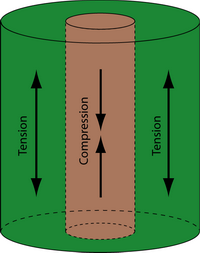The structure of wood (III)
The structure of the tree trunk has now been discussed at both the cellular and macroscopic scale. At the level of the complete structure, there is a further point of interest: the tree is pre-stressed. The centre of tree trunk is in compression, and the outer layers are in tension. The stressing is achieved as the inner sapwood shrinks as it dries and becomes heartwood. As the heartwood has lower moisture content it is better able to resist compression.

Regions of tree trunk in compression and tension
Try the interactive tree bending demonstration below. Compare the bending of the pre-stressed and not pre-stressed trees in a strong wind, paying attention to the graphs showing the areas of the tree trunk in tension and compression.
When a tree grows, the new cells grow at the edge of the tree from the vascular cambium. At the beginning of the growing season, in spring, the cells that grow are large due to the greater amount of moisture available. Throughout summer, the moisture available decreases and the cells also decrease in size as a result. By winter cells can no longer grow, and cells at the edge of the sapwood region near the central heartwood dry out and die. This sequence is evident as annual growth rings. This process is used to date trees by dendrochronology. In a good growing year, the growth ring will be wider than that in a bad growing year. By working out the sequence of good and bad years it is possible to match this sequence to the tree, as long as it is more than fifty years old when felled, and hence find the age of the tree. Close examination of the last growth ring then pinpoints the actual season that the tree was cut down. This technique was used to date the oldest-known timber track-way in the world, Sweet Track in the Somerset levels, to the winter of 3807 to 3806 BC.

